|
10/04/2018 - Imprinting foals Santo Stefano
The first moments of life are extremely important for the relationship between the newborn foal and human beings. This very first contact has been called "Prägung" (imprinting") by the famous animal
psychologist Conrad Lorenz. The presence and assistance of the owner creates an atmosphere of trust and well-being in the relationship between newborn foal and men, but also an atmosphere of trust between the mother and their
owners. We are always present when our mares are giving birth helping, soothing and assisting when it is necessary. Touch and voice contact are extremely important also during the mares' pregnancy. We are convinced that the foal
already knows us before it gets delivered into this world.
The first gulp of milk (colostrum) full with valuable protecting substances milked from the mother is supplied by us immediately after cleaning and disinfecting the umbilical cord. Then we help the little
creature to get up and to find the mother's udder. These very intimate moments where only we are present without intruding or disturbing the relation between mother and newborn are the "imprinting" that makes SANTO STEFANO horses so special.
ABOVE LEFT: Drying the foal with a clean towel right after it came out of the mother's womb
CENTER: applying the first 250 g of collostrum taken from the mare milking her to get used to the tickling touch of her foal afterwards. The collostrum contains all the essential
antibodies and is given from a baby drinking bottle with dummy (big hole).
RIGHT: cuddling the foal and rubbing him with a clean towel with the mother watching
(conferring trust in the human being)
BELOW LEFT: playing with the foal and encouraging him when he gets up for the first time
BELOW CENTRE: 3rd day, first time outside
BELOW RIGHT: encouraging the foal to leave his box with mom and human (trust)
have a look
at http://www.scuderia-santo-stefano.com/imprinting.htm
06/04/2018 - Interview EURODRESSAGE
Santo
Stefano Putting Sport Horse Breeding in Italy on the Map
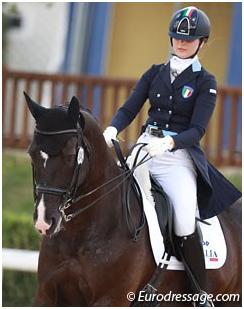
Eurodressage F.O.C.U.S.
Scuderia Santo Stefano
in Le Marche, Italy, is the brain child of British-German born Barbara
Fuchs, who boasts 25 years of experience in versatile sport horse breeding.
With a philosophy grappled to the German model of breeding and raising
top quality sport horses, Fuchs has successfully realized her visions and
dreams at brood farm Santo Stefano in Italy. Scuderia Santo Stefano now
has home-bred sport horses competing at international FEI level across
the Olympic disciplines.
Barbara Fuchs worked
as a journalist in Germany for years before she got fed up with wise-cracking
people who understood nothing about horses and used them only to improve
their image. She and her husband Eberhard bought an old farmhouse in a
very remote area of Italy, renovated the property and moved there with
three brood mares. It was the beginning of Scuderia Santo Stefano.
Building from the
Ground Up
Since 1992 Scuderia
Santo Stefano has been breeding sports horses in Italy with an exclusive
focus on German bloodlines. All horses are now registered as Italian warmbloods
(S.I.) with the intention of providing the Italian equestrian market the
expertise of decades of intelligent German horse breeding. "We aim to create
our own brand, Santo Stefano Dressage Horses, in the same way as Leon Melchior
did in Belgium with his Zangersheide show jumping horses," said Barbara
Fuchs.
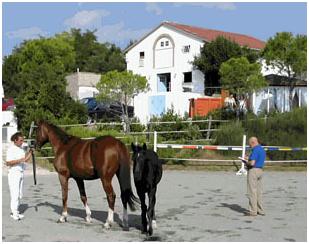
Scuderia Santo Stefano
Santo Stefano has
a versatile breeding program focusing both on dressage and show jumping.
A dressage horse needs the elasticity and scope to clear a fence, as well
as have the right attitude not to freak out in the face of an obstacle.
"We want to produce and educate reliable horses, so that also young riders
can deal with them," Fuchs explained.
The majority of
Santo Stefano's bloodlines are based on the old lines of the great proven
German sires such as Rubinstein, Rohdiamant, Fabriano, Escudo, Bolero,
Donnerhall, Don Frederico, Wolkentanz and Weltmeyer. They currently stock
45 youngsters on their 4.5 hectares of land and have bred more than 100
horses so far.
"We have always
believed in starting with brood mares with good pedigrees instead of only
running after famous sires. Many of our mares were given to us for free,
because Italian riders spent a lot of money on them at auctions and found
out after a few months that they were not able to ride them," Fuchs admitted.
"It is very disappointing to us that German stallions, that were advertised
fiercely, disappeared from the market after a couple of years because either
they had shown faults or were sold abroad at ridiculously high prices."
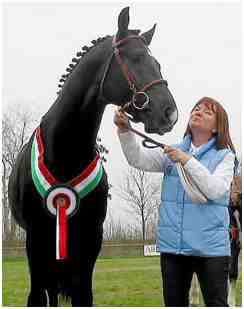
Barbara Fuchs and
Corde Santo Stefano
Santo Stefano has
also been standing their own home bred stallion at stud, the 17-year old
Corde Santo Stefano (by Cheenook x Chairman x Cor de la Bryere). He is
a performance test winner with the best result ever in an Italian performance
test (911 out of 1000 for gaits and character) and competing in show jumping.
"We have covered
most of our 13 breeding mares with him for the past ten years," Fuchs explained.
"We now have undeniable proof that all his offspring inherit his impeccable
character and outstanding gaits, as well as his talent for both disciplines:
dressage and show jumping. We breed good-natured, promising youngsters
with excellent ride ability that even a child can handle."
Santo Stefano's
Success in Sport
Barbara Fuchs is
a realist at heart and knows that breeding on paper does not work. She
avoids stepping into the pit-falls of marketing convincing inexperienced
breeders to go for unproven, young stallions with flashy gaits. In Italy
new equestrian centres and brood farms surface and publicly boast having
the best lines as they spent much money on fancy stallions and auction
horses. However many of them do not survive nor persist in their grand
goals, and drop out when it comes to proving their philosophy in sport.
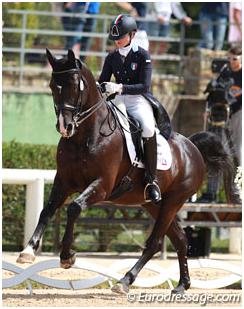
Camilla Mauro on
Santo Stefano Francis
"We do not aim at
the stars right from the beginning," said Fuchs who keeps both her feet
on the ground. "In the 25 years of breeding experience we have learnt that
can breed the best bloodlines you'll ever find, but it won't mean a thing
if you do not find the appropriate riders who can take your horses to the
top."
Fuchs explained
that she shares the same vision as Carl Hester, which he explained in his
book "Making it Happen": horsemanship and good dressage training to take
horses up the levels instead of buying hypersensitive super stars that
only professionals can handle.
Santo Stefano's
most successful breeding product in the dressage arena is Santo Stefano
Francis, a 14-year old Hanoverian registered gelding by Fabriano out of
Wenzi (by Wenzel II), who took Italian Camilla Mauro to two European Junior
Riders Championships (2012, 2014). Italian young rider Francesco
Neri is currently ranked 80th on the FEI World Ranking List for Young Riders
on Santo Stefano Ramas, a 14-year old Italian warmblood by Rubinstein out
of Pyrah (by Polydor).
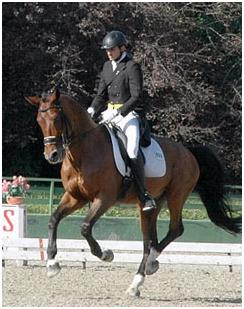
Francesco Neri on
Ramas Santo Stefano
Italian 12-year
old (!) Andrea Neri rode the 11-year old Italian warmblood Leo Pascal Santo
Stefano (by Londonderry x Wenzel II) at the 2015 inaugural European Championships
for Children to finish 23rd in the team championship test. The show jumper
Santo Stefano Gianna, a 15-year old Hanoverian by Grandom out of Lorena
K (by Legat) has been competing internationally at Grand Prix level in
3* CSI events under Italian Stefano Magaro.
Barbara Fuchs has
also given the ride on Rhaoul Santo Stefano (by Rohdiamant x Chromatic
xx) to a young Italian rider Laura Sanna, who has started competing him
at E-level and is working her way up to Grand Prix under the guidance of
Dutch trainer Joyce Heuitink.
Swimming Against
the Tide in Italy
Fuchs openly admits
that making a change in the Italian breeding and dressage world is like
swimming against the tide. She points the finger at the lack of knowledge
and understanding within the authorities -- the Italian Equestrian Federation
(FISE) - as well Italy's betting mentality that show jumping and dressage
are an opportunity to gamble and make money like racing.
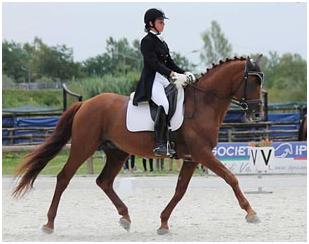
Laura Sanna on Rhaoul
Santo Stefano
"We can't sell foals
at the age of six months as we should, because people are not capable of
raising a young horse," said Fuchs. "Horses stay with us until they are
four years old with all the costs for starting them. Even then it's difficult
because there are only a few people capable of training a young horse.
We are expected to sell horses ready to go to competitions and, of course,
to win. A typical question: "How high does
he jump?" The horse
should be 'experienced' and "please, he should not throw off his rider"
never mind how much he pulls the horse's mouth or attacks with spurs! You
will agree, this is asking very much from horse breeders who are, furthermore,
expected to sell for "half the price" because Italy is so much in crisis."
Fuchs is also highy
critical of the poor performances of the Italian riders at the 2015 European
Dressage Championships in Aachen, where Team Italy finished last. Two of
its riders were unable to fulfil FISE's own-set team selection criteria
of 3x 66% in the Grand Prix, but the Italian Dressage Committee still decided
to field a team, pressured by Italian dressage bobo's.
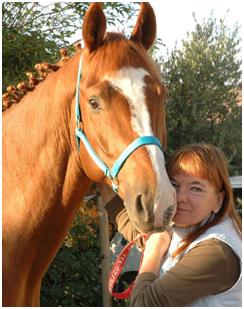
Fuchs with Leo Pascal
Santo Stefano, who competed at the 2015 European Children's Championships
in Vidauban
"The Italian performances
in Aachen were devastating. I got really depressed realizing that I have
put 25 years into breeding horses for people that will never get dressage
off the ground," Fuchs admitted. "The Italian press makes it sounds as
if the country has won the Europeans and does not even mention that they
finished last. Officials cite poor excuses that it is all due to the fact
that the horses are too old and say the riders were brilliant. They say
it is the fault of FISE. I wonder why other small countries performed well,
such as Norway, Finland, Belgium, Luxembourg, Denmark, all by themselves
without help from their federations, but with efficient trainers?!"
Fuchs is certain
that the problem is not the lack of horse quality in Italy, but the lack
of knowledgeable people to train riders and horses.
"Four generations
of young people have been tought to ride wrongly. They are not capable
to sit in balance without tearing the horses in the mouth, leaning backwards
and stretching their feet to the front," she said frankly. "And if there
is somebody talented like Camilla Mauro, they disappear from the scene
because they do not have the money to continue and were put off by the
inefficiency and lack of support from FISE."
According to Fuchs,
there is no protection and encouragement from the Italian breeding authorities,
UNIRE/ASSI/MIPAV nor the Federation.
"The market is full
of unauthorized dealers who buy cheap horses with either physical or mental
defects, triple the price, and resell them in Italy to unsuspecting customers
who think they have a bargain. Terrible accidents happen because un-qualified
trainers who had their share in the deal are not capable of training these
poor people and their horses," Fuchs continued.
Staying Positive
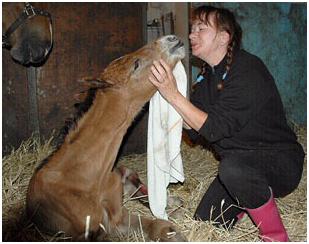
Working with foals
on a daily basis brings Barbara Fuchs much joy
Fortunately Barbara
finds happiness in her own breeding yard and the daily life at Santo Stefano.
The growing partnerships with the Neri kids and their Santo Stefano horses,
Laura Sanna on Rhaoul Santo Stefano, Giada Tanzi on Corvo Santo Stefano,
as well as Mauro's fantastic successes on Santo Stefano Francis give her
a boost of energy.
"We try to be optimistic
of the future in spite of all the difficulties and economic problems we
have to face every day. Cor de la Bryere�s owner in Holstein was convinced
of his horse despite all the criticism he received from most of his contemporaries
and we try to follow his example," Barbara explained. "We are convinced
that Corde Santo Stefano has inherited all his ancestors' qualities and
will pass them on to his foals. He was given to us by destiny and we are
supposed to fulfil our task as breeders. We try to be optimistic in spite
of many obstacles, convincing our-selves every day: "Yes, we can!"
For more information
about Santo Stefano, visit www.scuderia-santo-stefano.com
|
|
05/04/2018 - Interview with Jean Llewellyn of Breeding News for sport horses

Breeding News for Sport Horses
Santo Stefano: "Yes
we can!"
Original wording
ITALY (by Jean Llewellyn)
Based in Le Marche
in eastern Italy, almost due west of Senigallia on the Adriatic coast,
the stud farm of
Santo Stefano occupies
a remote area of steeply undulating terrain surrounded by rich agricultural
land ideal for breeding and raising
top-quality sport horses. For Barbara Fuchs, horses have been a life-long
passion that began in Germany.
» What is your background,
and when did you become a sport horse breeder?
By profession I am
an interpreter and journalist. The fist years of my life I spent in Westfalia
Germany with my Czech mother and my English father. From early childhood
I was
attracted by the
big framed, good natured horses that grew there.
I was longing to
take riding lessons, but when my parents separated and I was living with
my mother there was
no money for this
kind of luxury. So I accompanied a school friend from a rich family when
she took lessons in show
jumping absorbing
everything I saw. I cleaned horses for other people, eventually being allowed
to sit on them and to
become part
of the vaulting
team, an activity I enjoyed very much. A
t the age of eighteen
I went to England for my studies and couldn't afford riding lessons there
either. My first job was in Berlin and with the money I earned I tried
to make up for the past by taking three or four riding lessons every day
in dressage and show jumping. My trainers were ex-military
and very tough.
It took me a few years to find out that my talent was not sufficient to
reach the top rankings, but there was the burning love for horses and the
desire to be near them,
to train and educate
young horses.
My work then took me to Munich where I met my future husband, journalist and author Eberhard
Fuchs. After a few years in journalism we both got fed up with wisecracking
people who understood nothing about horses, using them only to improve
their image. So we bought an old farmhouse in a very remote area of Italy
(Le Marche), restored it, packed up our three mares (Westfalian origins)
and went to live in Italy.
In 1991 our mare
Princess (Paradox I) had her first foal Contessa (Chairman x Cor de la
Byere), later the dam of Corde (Cheenook x Caretino x Cor de la Bryere).
We became fascinated by Cor de la Bryere's story and his owner, who fought
for him all his life, so decided to create our own brand, Santo Stefano,
Sella Italiano (SI) , using the ancient German bloodlines that had proven
themselves to be so reliable. We focused on Frühling (the sire of
my first jumping horse)
and Cor de la Bryere.
» Tell us something
about your stud farm?
We started with three
mares and one stallion, Weltrecord (Weltmeister) . Since 1992 we have bred
more than 100 horses all listed with UNIRE (now ASSI) under the brand
name Santo Stefano.
We have 4.5 hectares of land (all paddocks) which is not sufficient, but
have not been able to afford to buy three adjoining hectares. We are constantly
surrounded by 45 of our own youngsters, working with them 365 day a year.
There is one professional rider (usually from abroad since the quality
of Italian riders is lower than our requirements), and three young Italians
working for us on a freelance basis.
My husband and I
own a consulting company for for-eigners who buy houses (not horses!) in
Italy, and do free-lance work profes-sionally, since you cannot make a
living from horse breeding.
» What were your
philosophies in terms of bloodlines when
you started breeding,
and have they changed with time?
Like every beginner
we were attracted to fashionable names like Weltmeyer, Fabri-ano, Graf
Grannus, Escudo I, El Bundy, Londonderry, Le Primeur, Rotspon, Rohdia-mant,
Rubinstein I.... I admired very much Gudrun Vorwerk and her husband Hochen
Happ, famous German breeders, who helped me a lot with their advice, but
later gave up horse-breeding altogether.
For us it became
more important to have breeding mares with good pedigrees instead of running
after famous sires. Many of our mares were given to us for free because
Italian riders had spent a lot of money for them at foreign auctions
and found after
a few months that they were not able to
handle their beautiful
female. Unfortunately, standards of
riding differ too
much between Northern Europe and this country. It was very disappointing
to us that German stallions that were advertised fiercely, disappeared
from the market after a couple of years because either they had shown faults
or were sold abroad
at ridiculously high prices.
We always bred three
or four foals from the same
dam/stallion constellations
and studied the youngsters from birth through their "starting", which we
still do ourselves according to the method of Rudolf Zeilinger. We soon
realized that it is impossible to predict what becomes of a foal, even
if the sire and dam are the same! There are certain re-semblances, yes,
but like in human beings in a family with same father and same mother you
cannot plan things like looks, intelligence, etc. If a father is a good-looking
important scientist and has three children with the same wife, nobody can guarantee
that his off-spring will inherit his talents. And the same goes with horses.
No guarantees. There are so many other factors that count: upbringing,
imprinting, starting and most important - the rider!
» Because of today's
stallion choices, many breeders
choose to only have
mares - why did you choose to also
have your own stallions?
It has always been
our philosophy that males born at Santo Stefano remain stallions, unless
they have health problems - like our Rubes (Rubinstein I - who died from
a torsion of his testicles). At an early age Rubes started to show the
same symptoms, so we reluctantly decided to have him castrated. Since the
performance test
for stallions was abolished in Italy after 10 years of struggling, stallions
can qualify as a per-former by sporting results, and we feel we should
give our stallions a eh-once to do so! All our stallions have a special
upbringing with imprinting, they are all well-behaved and can be
ridden and handled
also by non-professionals. So why
should we castrate
them and later - when they prove to be successful - regret that we eliminated
a promising gene
pool?
» Tell us about your
current string of horses in terms of breeding stock?
Since we are lucky
to have had our own performance stallion, the Cor de la Bryere in-bred
Corde - who was born at Santo Stefano 30 years after his famous maternal
grandfather, and paternal great-grandfather who was born on precisely the
same date (April 23) in 1968 - we have covered most of
our 13 breeding
mares with him for the past three or four years. We now have undeniable
proof that all his offspring inherit his impeccable character and outstanding
gaits, as
well as his talent
for both disciplines: dressage and show jumping. We breed good-natured,
promising youngsters with excellent ride ability that even a child can
handle.
» What about the
horses you've bred that are now competing?
We are very proud
that two of our horses have qualified
for the European
junior dressage championships in
Switzerland (July
8-12 in Bern): Santo Stefano Francis (Fabriano x Wenzel II, born 2001)
will participate with 16-year-old Italian Camilla Mauro; and the stallion
Ramas Santo Stefano (Rubinstein I x Polydor, 2001), with 1
7-year-old Italian
Francesco Neri. We have been able
to insert Francesco
into Anky van Grunsven's successful e-Learning program, in that we are
sending training videos to Anky and she comments personally on a horse
and rider's progress giving useful advice. Having two horses in such an
important international, competition - no matter what their scores will
be- is proof of our philosophy. We breed reliable horses that can be prepared
and handled even by inex-perienced young people.
Cordalme Santo Stefano
(Corde x Alme, 2006) is
successfully competing
in Holland in the six-year-old
circuit with his
Swedish rider hoping to qualify for Lanaken. Another striking horse from
our stud is Don Rubino (black stallion by Don Frederico x Rubinstein I,
2006) chosen
by Piero Sangiorgi
(so far Italy's only Olympic Games dressage participant) to be trained
for his future career.
Many of our young
horses have been bought by owners
in their fifties
who want a reliable horse for national competitions. They are all very
successful and happy, though not competing in high international categories
which would of course add to the fame of Santo Stefano. For us it is very
important that our horses bring happiness to people's
lives who otherwise
would have given up riding a long time ago.
» Do you have a master
plan for each foal in terms of sales and/or training?
Of course, each foal
born at Santo Stefano is something special - my husband and I are always
present to support the mare and foal during labour. We leave them with
their
mothers for eight
months so they will learn confidence in humans from them. They then they
grow up in pairs living
in one big box and
paddocks (stallions included) till the age of three, when we gradually
and carefully adapt them to saddle, rider, and loose jumping. It is all
very individual according to a horse's talent, never hurrying. When a rider
gets into the
saddle it's as if
they had carried somebody their whole life.
Our horses are advertised
on our website, their whole career documented. A new owner finds them,
tries them out, and buys from us directly. If we feel the person is not
right for the horse or vice-versa, we discourage. One principle: Never
disappoint a client, rather say "no". Of course, this is very hard from
the economic point of view, and we have only recently started to place
horses abroad.
» What are the specific
difficulties of breeding in Italy today? The economics? Is it even possible
to make enough money from breeding alone?
The difficulties
of breeding sport horses in Italy is not only economic. There is a lack
of knowledge and understanding
on the part of the
authorities. A 'betting' mentality that riding
is not a sport but
an opportunity to gamble and to make money like in trotting and racing.
We can't sell foals at the age of six months, as we should, because people
are not capable of raising a young horse. Horses stay with us until they
are four years old, with all the costs for starting them. Even then it's
difficult be-cause there are only a few people capable of training a young
horse. We are expected to sell horses ready to go to competitions and,
of course, to win. A typical question: "How high does he jump?" The horse
should be 'experienced' and "please, he should not throw off his rider"
never mind how much he pulls
the horse's mouth
or attacks with spurs! You will agree, this is asking very much from horse
breeders who are, furthermore, expected to sell for "half the price" because
Italy is so much in crisis.
» What do you feel
about the administration of Italy's breeding industry and how would you
like to see things improve?
There is no protection
and encouragement from the Italian breeding authorities, UNIRE/ASSI and
the Federation. The market is full of unauthorized dealers who buy cheap
horses with either physical or mental defects from Belgium, Holland and
Germany, triple the price, and resell them in Italy to unsuspecting customers
who think they have a bargain.
Terrible accidents
happen because unqualified trainers who had their share in the deal are
not capable of training these poor people and their horses. Once someone
is disappointed, their custom is lost to the market because they give up
riding altogether. There should be strict market controls. A solution like
in Switzerland, where you are only allowed to import a horse if you can
prove that you already own a Swiss-bred horse.
Italian breeders
should be sponsored to send their young horses to shows. For instance,
transport, registration fees and rent for stables should be free for three-,
four-, five-, six- and seven-year-old horses still owned by their breeder.
We have 15 horses that should be presented in shows this season, but we
cannot afford 15 x €500 = €7,500 every month, plus the fees and accommodation
for the rider. There are no clever training programmes for young people
either, like in Germany or Switzerland, where you obtain qualifications
without spending a lot of money. In Italy you have to participate in costly
shows to gather points towards certain qualification. People who do not
have the money to participate are lost. A lot of talent is wasted.
» Do you consider
yourself an 'optimist' or a 'realist' where sport horse breeding is concerned?
The enthusiasm we
started with 20 years ago has diminished considerably due to quite a few
disappointments. Never with our horses, but with people. There are too
many cynics, seeing horses merely as tools, not giving them a chance to
develop. Too many unprofessional vets who, unable to provide a proper diagnosis,
tell you to put a horse down. This has happened twice with very good dressage
horses. Fortunately we did not give in and the previously condemned horses
are now successfully competing in their respective circuits. Still, looking
at Santo Stefano horses every day, we try to be optimistic for their future
in spite of all the difficulties and economic problems we have to face
every day. We still try to follow the example of Cor de la Bryere�s owner
in Holstein who was convinced of his horse despite all the criticism he
received from most of his contemporaries. We are convinced that our Corde
Santo Stefano has inherited all his ancestors' qualities and will pass
them on to his foals. He was given to us by destiny and we are supposed
to fulfil our task as breeders. We try to be optimistic in spite of many
obstacles, convincing our-selves every day: "Yes, we can!"
|